Aesthetically Designed Architectural Door Openings
Making deliberate design decisions without compromising quality or function
![]() Continuing Education
Continuing Education
Use the following learning objectives to focus your study while reading this month’s Continuing Education article.
Learning Objectives - After reading this article, you will be able to:
- Write clear, correct, and concise specifications for aesthetically designed architectural openings that are also code compliant.
- Explore the benefits and understand the challenges of utilizing aesthetic doors and hardware.
- Recognize the various codes as related to doors and hardware, which affect the product selection.
- Describe various designs and color/ finishes available to create an aesthetically pleasing opening.
Virtually every building project, new construction, or renovation requires attention to door openings. Properly located, they direct flow and movement through spaces for functional and safety purposes. The nature of door openings, however, is that they are made up of many individual components including wood, metal or glass doors, door frames, hardware, trim, closers, etc. Architects can sometimes view selecting and specifying all of these components on multiple doors as a bit of a chore, particularly if the focus is only on meeting life safety codes and other basic requirements. However, when coordinated and integrated door openings are recognized as truly significant design elements in interior spaces, they become real opportunities to move beyond the basics and enhance the overall building design and the indoor environment.
The Aesthetics of Door Openings
At a purely human level, door openings are the usual point where we actually touch the building and pass through one space to another. That experience can help us interact with the rest of the building when the door opening elements create unity with and reinforce the dominant design concept of the building. Conversely, when the door opening details are loosely coordinated, or worse, left to chance selection by others, then the experience of interacting with a door opening is less than positive. Since a lot of time and energy is usually expended to ensure harmony between all of the other functional and visual aspects of an interior space, it clearly follows that the design and integration of door openings significantly contributes to the success of any interior design.
Many successful architects have understood this concept of design integration based on using a strong unifying concept. Eero Saarinen for example produced designs that were indisputably invigorated by his passion for harmonious detail. He believed that good design respects context such that a lever on a door relates to a door in a frame which relates to a frame on a wall which in turn relates to a wall in a room while the room is connected to a building, and so on. He and other successful designers wouldn't delegate these important design elements to contractors or suppliers nor would they rely only on submittals to make product selections or determinations. Rather, they have given us the example of starting early in the programming, planning, or schematic design phases to identify their overall design concept and assure that door openings are considered as a consistent and integrated part of it. They are such strong contributors of the experience of the space, that to wait until later project phases overlooks the design impact of integrating door openings into the design at the earliest stages.
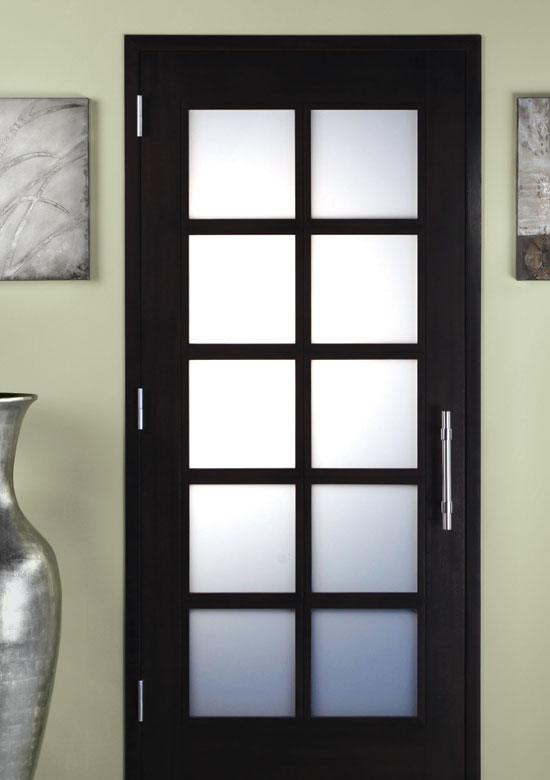 |
Truly aesthetic door openings result from coordination of all door assembly components and deliberately integrating them with the overall design of the spaces they serve. Photo courtesy of ASSA ABLOY |
When designing and specifying door openings and each of their component pieces, other criteria certainly come into play and must be accounted for as well. Appropriate fire ratings of doors and frames need to be provided in all fire-rated walls. In many settings, the issue of appropriate isolation for security or access control is important. Increasingly, sound control is an issue in interior spaces either for privacy or to meet green building standards. And the materials used for door opening components should of course contribute to energy efficiency, sustainable design, and good construction practices.
The good news in thinking about all of these other criteria is that none of them need to be a cause for design compromise. The marketplace has provided a full array of door opening components that can readily meet the various performance criteria and still be consistent with the overall aesthetic and building design. That means it is often very easy to start with the design concept and aesthetic of door openings first, and then readily be able to specify products that can meet the other code and functional requirements.
With all of the above in mind, let's turn our attention to each of the individual components of door openings and look at how the balance between design aesthetic and technical performance is readily achieved in each.
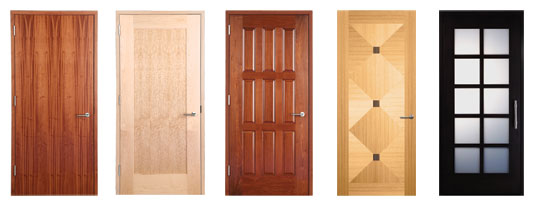 |
Some common wood doors in both flush and stile and rail types. Photos courtesy of ASSA ABLOY |
Door Frames—Defining the Opening
Once a door opening is designed into a space and located in a wall, that opening needs to be framed in some manner to serve several purposes. First, the frame closes off and trims the wall construction. Second, the door frame supports the door itself and provides the means for assuring a plumb and level condition. And in cases where it is needed, the door frame contributes to the integrity of a fire rating. Beyond providing these basic functions, however, there are actually many choices of door frames available to work with many different design conditions.
Hollow Metal Frames
Hollow metal frames are the default door frame for many commercial and institutional building designs. They are proven, durable, economical, and suitable for a wide variety of settings. Beyond that, hollow metal door frame profiles are available in a wide variety of shapes and sizes that can make them less visible or more prominent to suit an overall design scheme. This means that beginning with the wall opening itself, the visual framed appearance of that opening can be controlled in terms of how much or how little of the frame to make visible and in terms of what three-dimensional form that frame takes.
 |
Door frames are not limited to just a standard 2-inch flat face. A wide variety of prominent or subtle profiles are available to suit different design aesthetics. Images courtesy of ASSA ABLOY |
In some cases doors and frames are part of a wall that is performing a thermal separation as between indoors and outdoors or between two rooms that have very different normal operating temperatures. In that case, energy-efficient hollow metal frames are the most appropriate to use. There are two common types:
Thermally broken frames are fabricated to interrupt direct heat transfer through the metal frame by fabricating them in two parts with a less conductive material in between. They work the same way that thermal breaks in metal windows work and in that regard they are suitable to reduce heat loss anywhere that thermally broken windows are used. These door frames are ideal for openings directly exposed to cold or hot temperature differences between the two sides. In the case of exposure to cold, they can be an effective deterrent to frost and condensation that might otherwise form on the metal frame.
Kerf frames are not typically thermally broken, but they do address another concern—air sealing the door using weather-stripping. Now, in reality, most door frames can receive weather stripping; it's just that a kerf frame makes it easier by virtue of an integral groove manufactured into the profile of the entire frame. This groove means that the installation of the weather stripping is simplified and that no additional fasteners are required to hold it in place.
Aluminum Frames
Aluminum frames are usually part of a system designed for both doors and windows and might, in fact, form the entire wall. They are suitable for interior situations where the intent is to maximize the penetration of daylight into rooms. They can integrate into standard drywall partitions but can also be adapted to accommodate varying wall conditions such as angled, segmented, and radiused frame configurations. It is possible to choose standard or custom anodized finishes, or electrostatically applied painted finishes as may suit the design intent of the rooms.
 |
Aluminum frame systems allow for interior doors and windows to provide large amounts of daylight to spread through a building interior. Photo courtesy of ASSA ABLOY |
In terms of the actual aluminum frame elements, there are two types. A classic system frame—the original frame system in the industry—screws into a gypsum board partition and requires taping and floating to finish. Classic systems can accommodate ¼-inch and 3/8-inch single glazing. By contrast, a trim-style system frame is a modular system that was developed for greater versatility and strength, and easier installation. It uses snap-on trim that conceals the fasteners and provides clean design lines. Trim-style frames are installed after the walls are finished and painted, which removes it from critical path scheduling and makes it very appropriate for design-build or fast-track fit-out projects. Trim-style systems can accommodate 1¼-inch, 3/8-inch, and ½-inch single glazing.
Wood Casings
In design situations where wood is the preferred frame material, wood casings form the door frames and are installed around the exposed faces of the door opening. The junction of the wood casing and the wall may or may not then be covered with separate pieces of wood trim in whatever profile is desired. In many cases, the use of wood is the most appropriate to be consistent with an overall design scheme. There is a misperception that they can only be used in cases where a fire rating is not required. However, since both non-rated and fire-rated frames and jambs are in fact readily available, their use does not need to be restricted because of fire rating concerns. Frames and jambs are available with 20-minute, 45-minute, 60-minute, and 90-minute ratings. Full frames are rated under positive or neutral pressure and in the case of using jambs only, they need to meet or exceed the rating of the door.
Doors—Filling the Void
With the frame appropriately integrated into the wall, the door itself needs to be selected next. Here, a deliberate choice can be made based on the overall design criteria and it is very likely that all code and functional requirements can be met within that selection. Of course, different door types and styles will appeal to different design situations, but some of the common choices and characteristics are explained as follows:
Hollow Metal Doors
As with frames, metal is a common material choice. The door faces are available in primed or pre-painted metal while unfinished stainless steel is also an option. The faces can be smooth or patterned of course, and for situations where the durability of steel is needed but a wood-like appearance is preferred, then it is even possible to specify an embossed wood-grain pattern on a metal door.
Inside the door, a core material needs to be inserted to provide integrity to the metal panels which can be specified to meet the specific performance requirements of the door. The common core choices include an open honeycomb fiberboard, solid polystyrene foam, polyurethane foam, solid mineral fiberboard, or a steel stiffened core. The choice of the core material will likely be the determinant of how the door performs in terms of fire rating, energy efficiency, sound transmission, overall strength, and even blast resistance. Since the core is then covered over by the selected metal faces, making it completely concealed, the design aesthetic is maintained regardless of the core selection made.
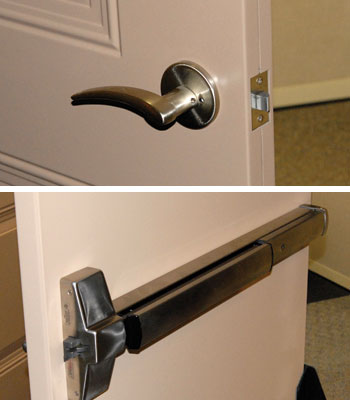 |
Hollow metal doors can be finished with exposed edge seams (top) or filled seams that are ground smooth (bottom). Photos courtesy of ASSA ABLOY |
One important aesthetic detail on hollow metal doors is the manner in which the edges of the door are treated. This is the area where the front and back panels come together and meet at or near the center of the door thickness. The specification choices include exposed seams, which produce a visible line or ridge at the side, top, and bottom of the door. The alternative is to specify that the edges be filled and ground smooth to eliminate the seams and create a more refined appearance.
Aluminum Doors
When aluminum doors are used, they are typically mostly or fully glazed, assembled, and packaged at the factory, complete with the frame. They also typically include accommodations for any special hardware preparation, thus making installation easier on site. Aluminum door types in particular are not limited to swinging doors but can be selected in a sliding barn door type or a pocket door type. Aluminum doors are commonly available in narrow (2-1/8 inches), medium (4-¼ inches), and wide stiles (5-½ inches).
Wood Doors
There are many choices and aesthetic options when the overall design calls for wood doors. The first and most basic choice is whether to use smooth flush doors or to incorporate a more three-dimensional stile and rail pattern into the doors. Stiles are the vertical support portions of the door on the sides. The rails are horizontal supports appropriately referred to by their location on the door such as top rails, bottom rails, and cross rails for intermediate locations. Either door type can create traditional or contemporary solutions, so an understanding of the possibilities becomes important in order to create door openings that truly work with the rest of the interior design.
For flush doors, the door face is obviously the most visible element with the biggest design impact. The face is typically a wood veneer over a substrate or crossband layer. That veneer can be any of a wide variety of species of wood, from almost any type of tree. When the wood is cut from the log, it can be done in a variety of ways that produce different wood grain appearances and different sizes of veneer pieces. The size of those pieces will determine whether the door appears with a single wood grain pattern or if several pieces are matched together to create other aesthetics. Hence the commonly used book-match or slip-match patterns of veneer can be selected instead of a full veneer piece. Custom or standard decorative patterns are possible that use multiple pieces of veneer, sometimes with multiple wood species, to create free form or geometric pattern to produce very artistically inspired results.
 |
A fully integrated door opening blends seamlessly with the rest of the interior design while still meeting the functional, safety, and code requirements of the space. Photo courtesy of ASSA ABLOY |
When it comes to flush door construction, the common manufacturing process is to create a five-ply product—a central core is one of the plies that is then covered on each side with two other plies—a crossband substrate layer and then the selected wood veneer. All four exposed edges of the core are covered with an internal set of supportive stiles that can have a smooth edge treatment that can be specified to match the door. Similar to hollow metal doors, the core material in wood doors can be selected on the basis of performance and code criteria. The five common choices are open honeycomb fiberboard, solid mineral material, composite of block and stave, particle board, and even a rapidly renewable agrifiber.
Moving on to stile and rail doors, the basic construction results in an appearance that is quite different. Solid pieces of wood are formed and used as the basic frame of a door with the stiles running vertically and the top and bottom rails running horizontally. Inside of this basic frame, many options exist.
For example, very traditional raised wood panels can be incorporated using intermediate cross rails and a center stile all of which is treated with traditional wood working techniques to create familiar historical looking doors. The details of the panels can vary to suit different historical or traditional styles using common joinery, molding, or overlays as may be appropriately selected. It is usually important, however that all of the wood used is either the same species or a compatible species that expands and contracts at the same rate. Another design option is not to use wood panels between the stiles and rails, but lites of glazing of one type or another. This can produce a more contemporary appearance if desired while still blending with other wood elements of the space.
Whether flush or stile and rail wood doors are used, the final detail to address is the finish. Either an opaque or a transparent stain is common to enhance the natural qualities of the wood grain. Final clear coats are then specified in the appropriate gloss or sheen. All finishes can be applied either in the field or at the factory based on project needs or the degree of finish control required.
Laminated Doors
There are two types of laminated doors available.
Thermally fused, low-pressure laminate (LPL) doors: LPL doors are fundamentally constructed in a simpler manner than other doors but can be aesthetically very pleasing, cost effective and durable. Virtually hundreds of decorative and wood-grain LPL veneer options are available that are adhered to a dense industrial grade particle board core. Matching edge-banding is used on the top, bottom, and sides thus avoiding the otherwise typical black lines at laminate seams. This overall process has proven itself such that the faces won't chip, crack, or delaminate while providing extensive finish and appearance options. From a sound transmission standpoint, a 43 STC rating is possible. Fire-rated LPL doors have 20, 45, 60, or 90 minute ratings. Non rated doors are also available with a recycled core.
High-pressure laminate (HPL) doors: These doors are finished with a common plastic laminate with a decorative or wood grain pattern. As such they provide a consistent appearance from opening to opening in locations where consistency is important. There are literally hundreds of decorative colors and patterns to choose from and the durable surface provides easy maintenance. Like LPL doors, the solid core is available in different densities to achieve different properties. There is also some additional flexibility in the core material used including green properties of recycled, rapidly renewable, FSC certified, or no added urea formaldehyde core material. HPL doors have been fire rated at 20, 45, 60, or 90 minutes and also provide favorable sound control.
Regardless of the type of door and frame selected, the important thing to remember is that early decisions on these items will enhance the design process and contribute to an overall, integrated, and coordinated aesthetic.
Hardware That Puts Everything Together
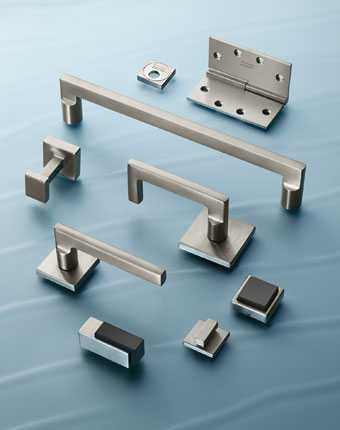 |
Decorative hardware choices can add to the overall look and aesthetic of a space. Photo courtesy of ASSA ABLOY |
Once the doors and frames are established in a design scheme, the next area of focus is the means to meet all of the functional operations of the door. That is accomplished through the appropriate and thoughtful selection and specification of hardware of various types. Again in this area, the choices are many such that the design aesthetic need not suffer but rather can be enhanced by the appropriate, deliberate selections made by the architect or designer.
Hanging Devices—Swing, Slide, or Hide
Once the doors and frames are selected, the design question is now how they are hung and how much hardware is needed or desired to be exposed. Typically, hinges in a variety of styles are used with varying degrees of visibility or intentional ornamentation. By contrast, door pivots can be used that are essentially concealed in the door and the floor at the bottom or at the head. They come in a variety of styles too such that the door can be made to pivot about its center or the pivot can be offset to push the door to a slightly different location when open. In some cases, if the door is meant to be self-opening as for handicapped accessible locations, an electrified, motorized system will be used. That can mean that the hinge itself needs to accommodate wiring.
The size and style of the hinge selected needs to accommodate the weight and height of the door while assuring that it will function properly over time. The common two knuckle hinge is appropriate for light duty doors as is a decorative “olive-knuckle” hinge. However doors that are located in higher traffic zones and are heavier in weight will be more readily served by three or five knuckle hinges. Taller doors will require more sets of hinges such that a standard light duty door that is 7 feet tall will do fine with 3 hinges (i.e. 1-½ pair) while taller doors will likely need 4 hinges (2 pair). The most durable of hinges is a continuous or “piano” style hinge that runs the full length of the door.
 |
Some available types of door hinges include (left to right) two-knuckle hinge with decorative tips, three-knuckle hinge with decorative tips, five-knuckle hinge, olive-knuckle hinge, and a square barrel hinge. Photos courtesy of ASSA ABLOY |
Hinges of all types can be fabricated in a variety of metals and finished in virtually any common metal coloring. They can also be fabricated to be more secure by virtue of having less ability to be disassembled either through the fasteners used or by design of the hinge itself. In either case, choices are available that will allow for exposed parts of hinges to blend with or complement a finished design aesthetic. In cases where this hardware is not desired to be exposed, then concealed hinges or pivots will be the best option.
One other consideration in hanging doors is that perhaps a hinged door is not the way to go at all. Rather, a sliding door may be more suitable in one of three varieties. A fully concealed sliding door will have a track and hardware that are pre-assembled and concealed within a wall as is common in residential and some light commercial applications. Alternatively, two sliding doors may overlap or the door may overlap an adjacent panel with the track and sliding mechanism covered over. Thirdly, a barn door style of slider is common in commercial and industrial settings with the door set to slide in front of a wall and cleanly close off an opening. In those cases the hardware will most likely be exposed but can be selected in a variety of styles that are either traditional or modern.
Securing Devices—Point of Contact
As mentioned earlier, hardware that is used to operate or secure a door is an integral part of experiencing a space. Since this is the point where we actually touch the building, it is also a point that we look at directly to understand how to operate it. That experience can be enhanced by the clarity of the aesthetics of the hardware or be diminished by a lack of aesthetics and integration.
The primary factor that drives the decision on what hardware to use is the intended function of the door. The overall term that describes the locking hardware on a door is the lockset which is typically made up of multiple pieces, both visible to the user and concealed inside. The lockset can be specified to function in a number of ways including:
• Entry function: Typically used on primary exterior doors, this type of locking set has operable handles with a keyed cylinder on the exterior side of the door and normally a turn piece on the interior side. Double cylinder sets are available that have a keyed cylinder on both sides of the door.
• Dummy function: A single dummy set has inoperable handles on one side of the door, while a full dummy set has fixed handles on both sides of the door. Dummy sets are typically used in conjunction with roller catches, flush bolts, or surface bolts.
• Push/pull function: A push/pull set has inoperable grip handles and/or escutcheons and can have locking mechanisms in single cylinder, double cylinder, or patio applications.
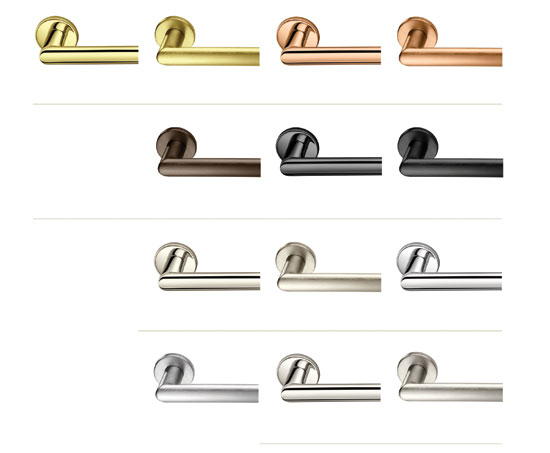 |
Door hardware is available in a range of metal colors and finishes. Images courtesy of ASSA ABLOY |
• Privacy function (spring latch): This set is locked by a push button from the interior side of the door and can be unlocked from the exterior side by an emergency release key.
• Privacy function (mortise bolt or mortise lock): Generally used where higher control is needed, privacy sets are available with mortise bolt or mortise lock mechanisms. They are characterized with operable handles that are locked by a turn piece from the interior side and may be unlocked by an emergency release key from the exterior.
- Emergency release refers to the capability of a lock to be unlocked from the exterior side in case of an urgent situation and is a common feature of most interior privacy lock sets.
- Exit devices are typically push bar style mechanisms that allow unencumbered egress from a space, typically used in higher occupancy areas such as public assembly areas.
Once the control function is decided upon, the lock trim materials can be selected. Lock trim refers specifically to the visible portions of the lock set that is usually attached to the surface of the door and can vary interchangeably with other parts of the lockset, including:
- Escutcheon – the back plate that attaches to the door.
- Swing Cover—the flap that covers the cylinder or the emergency release access.
- Thumb Piece—the part that retracts the latch bolt on a thumb latch entry lock set.
- Turn Piece—operates the dead bolt or mortise bolt on the interior side of a locking set.
- Handle—the part of the hardware set that is pulled or rotated to open/close the door. Juhani Pallasmaa, Honorary FAIA, Professor of Architecture, is quoted as saying “The door handle is the handshake of the building.” Since the handle is the part that we place our hands on, it is not surprising that there are many options, particularly for lever style mechanisms. Handle options include grips, levers, knobs, or ring pulls.
All of the hardware, particularly the exposed hardware, can be specified in a variety of metal colors and finishes. As such, they can blend with the overall design scheme of the space where they are located and contribute visually to the aesthetic experience.
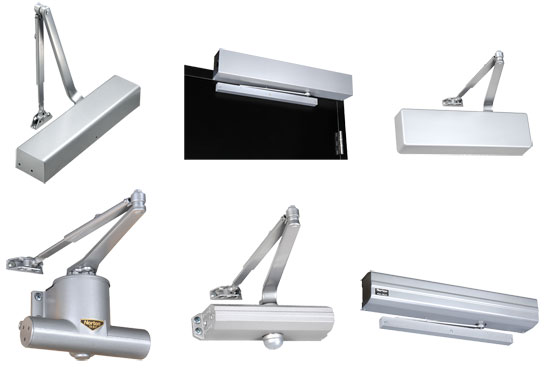 |
Door closers come in many shapes and sizes to accommodate the particular design needs of a door opening. It is important to coordinate their location on the door for best aesthetic results or use concealed closers to avoid visual conflicts. Photos courtesy of ASSA ABLOY |
Controlling Devices—Creating Closure
Doors that open also need to close and in many cases automatic closure is required by code since door closers maintain the integrity of fire doors along exit routes in buildings used by the general public. Similarly, to secure the function of any security door, it's critical that an automatic closing device such as a door closer is in place. The self-closing function offered by door closers also provides an important level of security for external doors, preventing them from slamming, staying open unintentionally or blowing open in the wind.
In response to these door control needs, the typical decision is to add a door closer that is mounted to both the door and the frame or some other fixed point. There are several typical choices:
- Surface closers: These are the most commonly used type of closer but aesthetically they can be a weak choice due to the exposed closure arm and rather functional look of many of them. There a variety of door closer types available ranging from surface mounted door closers, concealed door closers, door stays, floor closers, screen door closers to electromechanical door operators and closers for a variety of special needs. Some of the surface mounted types include Regular Arm (RA), Parallel Arm (PA), Top Jamb (TJ) or Slide Track operation.
- Concealed in head closers: This type is a designer's dream since all of the hardware is concealed in the door frame or head, not exposed on the outside of the door. Obviously this requires some coordination to be sure that the frame and door head can accommodate the door closing unit. It should also be pointed out that these do not function efficiently because there is little room in the body for optimal springs and hydraulics. They also require more adjustment and are not recommended for entrances or stair towers.
- Concealed floor closers: Similar to concealed head closers, door closers that are concealed in the floor are also out of sight and avoid any aesthetic interference with the look of the total door opening. Unlike concealed head closers, however, concealed floor closers are the most efficient way to hang and close a door. The closer carries the weight of the door on the floor and is completely out of sight. Obviously, coordination with the floor construction is needed to allow for the proper operation.
Protection—Keeping the Aesthetic
The flip side of doors being the place that gets touched by people is that they can also get exposed to heavy use and extreme and wear and tear. To keep the doors looking good over time, many different door accessories are readily available to add a layer of protection. These include push plates and pull plates in metal colors and finishes to match other door hardware. They can also be customized to blend with a predominant design style. Other items such as kick plates, and mop plates become necessary in heavy use or high traffic door openings, but may blend well with those settings if handled properly.
Trim—Meeting Code
Thresholds, door bottoms, and gaskets round out and finalize the details of a fully integrated door opening. Use and selection of these items is typically based on code requirements for energy efficiency, fire rating, or ADA-ANSI A117.1 compliance. Typically these items are surface mounted on door or on the door frame.
The usual reason to add these items is to provide effective air sealing around doors to control unwanted air infiltration. Gaskets are commonly used to fill seams around the jambs and door head while a bottom seal and threshold is used to eliminate the gap under the door. As mentioned under the door frame discussion, a kerf frame features a groove along the frame where it comes in contact with the door edge. As such, they simplify installation of weather-stripping by serving as a convenient channel for installation without using additional fasteners.
Openings with a pair of doors also require gasketing to seal the meeting stile. Gasketing is available in several materials that are flexible and do not impede the operation of the door. They can be specified in varying grades to meet the conditions of different climate zones. Common products include silicone, Santoprene (100 percent recyclable), vinyl, and polypropylene. When specifying gasketing, look for products that meet or exceed ANSI 156.22 Door Gasketing and Edge Seal Systems.
Conclusion—Integrate for Total Design
A common design process involves detailing and specifying doors, frames and hardware all as individual field assembled components. However, as we have seen throughout this article it is also entirely possible and desirable to create coordinated systems that are integrated together. There are even some pre-planned products available that have addressed the integration possibilities and teamed different components together. These are particularly well suited for cross-corridor and elevator lobby locations but may have other applications as well. They feature an integrated door, metal frame and hardware that is generally recessed or minimized. The whole approach is intended to provide fire separation doors that remain in a generally open position until triggered by an event which releases an automatic hold open device. These integrated assemblies are further intended to blend in with the surrounding wall surface and finishes. They are available in up to a 3-hour fire-rated assembly and vision lites are possible. The hardware usually includes an integrated, low-projection exit device and a top latching mechanism such that no central astragal is required.
Whether one of these coordinated systems is opted for or custom solutions are designed, the overall project is served best when the aesthetics of door openings is considered in the earliest phases of the design process. While integrating the frame, door, and hardware to meet a desired appearance and finish, door openings can also readily be specified to meet requirements of life safety, security, energy efficiency, and handicapped accessibility. Overall, then, the goal is to strive for continuity and harmony in door opening design. If all of the various parts aren't designed and coordinated to work together, the result is haphazard and detracts from the overall design intent of the spaces they are located in.
Additional References
Evidence Based Design for Healthcare: www.healthdesign.org
Codes:
National Fire Protection Association: www.nfpa.org
International Code Council (ICC): www.iccsafe.org
Institutes:
Construction Specifications Institute: www.csinet.org
Window & Door Manufacturers Assoc: zwww.wdma.com
Architectural Woodwork Institute: www.awinet.org
Door and Hardware Institute: www.dhi.org
United States Green Building Council: www.usgbc.org
ASSA ABLOY is the global leader in door opening solutions, dedicated to satisfying end-user needs for security, safety, convenience, good design, and sustainability. Their decorative door opening solutions comprise great-looking wood, aluminum, stainless steel, and hollow metal doors and frames with suited collections of door levers, pulls, stops, hooks, and hinges that bring harmonious detail to building interiors. Hundreds of beautiful solutions will inspire you. Call 845-742-4827 for specifications assistance or visit them at www.thegooddesignstudio.com |
